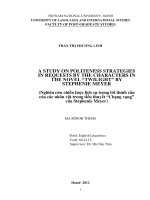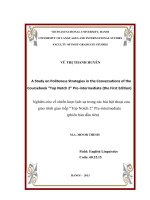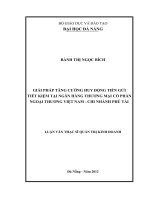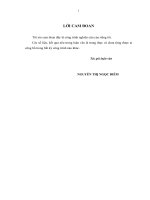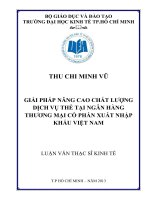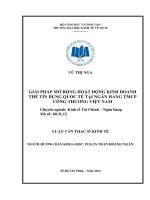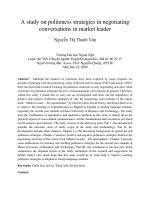(Luận văn thạc sĩ) a study on politeness strategies in requests by the characters in the novel twilight by stephenie meyer m a thesis linguistics 60 2
Bạn đang xem bản rút gọn của tài liệu. Xem và tải ngay bản đầy đủ của tài liệu tại đây (1.14 MB, 62 trang )
VIETNAM NATIONAL UNIVERSITY, HANOI
UNIVERSITY OF LANGUAGES AND INTERNATIONAL STUDIES
FACULTY OF POST-GRADUATE STUDIES
TRẦN THỊ PHƯƠNG LINH
A STUDY ON POLITENESS STRATEGIES
IN REQUESTS BY THE CHARACTERS IN
THE NOVEL “TWILIGHT” BY
STEPHENIE MEYER
(Nghiên cứu chiến lược lịch sự trong lời thỉnh cầu
của các nhân vật trong tiểu thuyết “Chạng vạng”
của Stephenie Meyer)
MA MINOR THESIS
Field: English Linguistics
Code: 60.22.15
Supervisor: Dr. Hà Cẩm Tâm
Hanoi- 2012
1
VIETNAM NATIONAL UNIVERSITY, HANOI
UNIVERSITY OF LANGUAGES AND INTERNATIONAL STUDIES
FACULTY OF POST-GRADUATE STUDIES
TRẦN THỊ PHƯƠNG LINH
A STUDY ON POLITENESS STRATEGIES
IN REQUESTS BY THE CHARACTERS IN
THE NOVEL “TWILIGHT” BY
STEPHENIE MEYER
(Nghiên cứu chiến lược lịch sự trong lời thỉnh cầu
của các nhân vật trong tiểu thuyết “Chạng vạng”
của Stephenie Meyer)
MA MINOR THESIS
Field: English Linguistics
Code: 60.22.15
Hanoi- 2012
2
TABLE OF CONTENTS
Declaration …………………………………………………………..….……
i
Acknowledgements……………………………………………………………. ii
Table of contents…………………………………………………………..…..
iii
Abbreviations…………………………………………………………..….…..
vi
List of tables ……………………………………………………………....…..
vii
List of figures…………………………………………………………….....…. viii
Abstract……………………………………………………………………….. ix
PART A: INTRODUCTION …………………………………………….…. 1
1. Rationale of the study…………………………………………….....…. 1
2. Aims of the study………………………………………………..…..… 2
3. Objectives of the study…………………………………………..…….. 3
4. Research questions………………………………………………..…… 3
5. Scope of the study………………………………………………...…....
3
6. Significance of the study…………………………………….………… 3
7. Methods of the study……………………………………………..…..... 4
8. Organization of the study………………………………………..……..
4
PART B: DEVELOPMENT……………………………………..………...... 5
CHAPTER 1: LITERATURE REVIEW…………………………………... 5
1.1. The speech act theory…………………………………………….…... 5
1.1.1. Speech acts……………………………………..………….…...
5
1.1.2. The speech act of request………………………………………. 6
1.2. Politeness…………………………………...…………………….…... 8
1.2.1. Politeness theory…………………………………………….…. 8
1.2.2. Social variables affecting politeness……………………………. 10
1.2.3. Politeness and indirectness. ……………………………………. 10
1.2.4. Politeness and indirectness in requests…………………………. 11
1.2.5. Modification……………………………………………..….…...
1.3. Previous studies on requests…………………………………….…...
v
14
14
CHAPTER 2: METHODOLOGY………………………………………….. 16
2.1. Research questions. ……………………………………………….…...
16
2.2. Data collection ………………………………………………….……... 16
2.3. Data analysis ………………………………………………………….. 16
2.4. Analytical framework…………………………………….………...….. 17
2.4.1. Alerters…………………………………………….……………. 17
2.4.2. Perspective………………………………………………………
17
2.4.3. Request strategies…………………………………….…………. 17
2.4.3.1. Direct requests- Category 1…………………….………
17
2.4.3.2 Conventionally indirect requests- Category 2……..…….
18
2.4.3.3. Non- conventionally indirect requests- Category 3……..
19
2.4.4. Internal modifications…………………………………………… 19
2.4.4.1. Syntactic downgraders…………………………………. 20
2.4.4.2. Lexical/phrasal downgraders…………………………...
20
2.4.4.3. Upgraders……………………………………………… 21
2.4.5. External modification……………………………………………
22
CHAPTER 3: DATA ANALYSIS…………………….……………………
23
3.1. Overview of “Twilight” …………………….…………………………..
23
3.2. Politeness strategies in request by the characters in “Twilight”………….. 23
3.2.1. The utilization of strategies.. ……..…………………………………… 23
3.2.2 The utilization of internal and external modifications……………...…… 28
3.3.3 Politeness strategies in requests in “Twilight”, seen from S-H
31
relationships………………………………………………………………….
PART C: CONCLUSION……………………………...…………….……… 40
1. Major findings and concluding remarks………………………………….
40
2. Implications …………….……………………………………………….. 41
3. Suggestions for further study………………………………….……….… 42
REFERENCES………………………………………...…………….………
vi
43
APPENDIX A: The coding system…………………………………...………
I
APPENDIX B: Sample of the coding procedure…………………….……….
II
APPENDIX C: The use of internal modifications by types in “Twilight”
IV
APPENDIX D: The polite request strategies in each group of speakers in
V
“Twilight” …………………………………………………
APPENDIX E: The use of internal modification in each group of speakers in
VI
“Twilight” ………………………………………..………….
APPENDIX F: Figures for illustrations…………........................................…..
vii
VII
ABBREVIATIONS
FTA
: Face- Threatening Act
IFDI
: Illocutionary Force Indicating Device
H
: The Hearer
S
: The Speaker
D
: Distance
P
: Relative Power
R
: Absolute ranking of imposition
(…)
: omitted words, phrases, or sentences
n
: Number of Appearance
DR
: Direct (Strategy)
CI
: Conventionally Indirect (Strategy)
NCI
: Non- Conventionally Indirect (Strategy)
SD
: Syntactic Downgrader
LPD
: Lexical/Phrasal Downdgrader
UD
: Upgrader
:
viii
LIST OF TABLES
Page
Table 1:
The balance of direct, conventionally indirect, and non-
24
conventionally indirect polite request strategies in “Twilight”
Table 2:
Polite request strategies by types in “Twilight”
25
Table 3:
The use of internal modificationsin “Twilight”
IV
Table 4:
The use of external modifications in “Twilight”
31
Table 5:
The
32
use of direct, conventionally indirect, and non-
conventionally indirect strategies in requests in “Twilight” seen
from the characters‟parameters
Table 6:
The use of internal modification in “Twilight” seen from S-H
36
relationship
Table 7:
The use of supportive moves in “Twilight” seen from S-H
relationship
ix
39
LIST OF FIGURES
Page
Figure 1:
The balance of direct, conventionally indirect, and non-
VII
conventionally indirect polite request strategies in “Twilight”
Figure 2:
Polite request strategies by types in “Twilight”
25
Figure 3:
The use of internal modifications in “Twilight”
29
Figure 4:
The use of external modifications in “Twilight”
VII
Figure 5:
The
use of direct, conventionally indirect, and non-
32
conventionally indirect strategies in requests in “Twilight” seen
from the characters‟ parameters
Figure 6:
The use of internal modification in “Twilight” seen from S-H
relationship
x
VII
ABSTRACT
The speech act of request is a face-threatening act in human‟s communication because
it challenges the mutual face of both the speaker and the hearer. The current study aims
to uncover how politeness strategies in requests are employed in the novel “Twilight” by
Stephenie Meyer. All the requests carrying the illocutionary force of getting somebody to
do something serve as the data source. The coding system is based on Blum-Kulka et. al
(1989) and Trosborg (1995)‟s coding manual. The findings show that the characters in
“Twilight” overwhelmingly chose the Direct Strategies in formulating their requests, in
which the Imperative Strategy or Mood Derivable was the most preferable strategy. On
the choice of Internal Modifications, the speakers in “Twilight” used a wide range of
mitigating devices within the Head Act to reduce the requestive force, mostly the
Question forms, Downtoners, and Past tense. With reference to External Modifications,
the speakers mostly chose Grounders to give reasons for their requests. The findings also
show that the choice of request strategies and mitigating devices was influenced by the
relationships between the characters.
xi
PART A: INTRODUCTION
1. Rationale of the study
Language, as stated by Crystal (1992:212), is “the systematic, conventional use
of sounds, signs, or written symbols in a human society for communication and
self-expression”. If communication is to be effective, both the speaker and the
hearer need to have shared knowledge; i.e., the same perception of what they are
talking about. In other words, people need to have communicative competence.
Hymes (1967, cited in Tam, 2005) asserts that communicative competence
includes not only knowledge of the linguistic forms of a language but also
knowledge of when, how and to whom it is appropriate to use these forms. In other
words, linguistic components; i.e. grammatical, lexical, phonologicalare not enough
for a language learner to avoid cultural shock, miscommunication or even
communication breakdown. Language learners thereforeshould acquire pragmatic
competence, i.e., the ability to perform language functions appropriately in social
contexts. Being aware of the importance of pragmatic ability, a lot of researchers
have drawn their attention to its crucial role, highlighted the significance of social
context, and made suggestions for appropriateness in communication.
The teaching and learning of foreign languages, including English has shifted
from linguistic forms of the target language to the communicative approach with
more emphasis on communicative competence in order to meet the demand of
global development. In line with this, the teaching and learning of English in
Vietnam has witnessed a great effort in improving learners‟ communicative
competence. More attention has been paid to oral skills and practice which stress on
the pragmatic meanings of utterances in contexts. Nevertheless, the traditional ways
of teaching and learning, which mainly focused on the development of linguistic
competence seem to hold its position as the prominent method. This leads to the
fact that Vietnamese learners appear to fail to communicate naturally and
appropriately in English. These learners may possess relatively good linguistic
knowledge to understand the structures and the words literally, but they fail to
achieve communicative goals because they may not be aware of the hidden or
unsaid meanings of utterances under certain settings, and
appropriateness
and
linguisticrealization
1
rulesfor
lack social
performing
and
respondingcommunicative acts. Unfortunately, while grammatical errors are likely
to be accepted by native speakers, English learners‟ pragmatic incompetence seems
to be much less tolerated, and is often consideredrude. This again highly appreciates
the importance of mastering saying the right thing at the right time to avoid
unintentional impoliteness, misunderstandings, or communication breakdown.
The speech act of request has been regarded as one of the face-threatening
acts (FTAs) in communication, since it intrinsically threatens the hearer‟s face and
is affected by social parameters (Brown and Levinson, 1987). Requests occur in
everyday life and play a leading role in human interaction as a vital part of
successful communication. Hence, many interlanguage and cross-cultural pragmatic
studies within different language backgrounds have widely examined the speech act
of request such as House & Kasper (1981, 1987), Blum-Kulka (1987), Blum-Kulka
et al. (1989), Trosborg (1995), Hassall (1999), Tam (2005). Most of those studies
focused on examining the use of pragmalinguistic formulae employed to express the
request head act and the modification devices that accompany it. Obviously, these
studies have investigated numerous aspects of the Head Act of request and provided
a relatively full understanding in single language, interlanguage, and cross-culture
pragmatics. However, there seems to remain gaps in literary genre that need to be
bridged since literature, as being judged, plays a significant role in our life,
especially the spiritual one. It has worked as a reflection of society and culture
(Thao, 2010); as a matter of fact, language, especially daily language used in a
literary works appears to be presented truthfully and naturally.
A long with the researcher‟s special personal interest in the topic, these factors
have created an urge for her to choose the minor thesis, namely “A study on
politeness strategies in requests used by characters in the novel“Twilight” by
Stephenie Meyer”. The study aims to investigate English native speakers‟ use of
polite request strategies and modification devices via the language employed by the
characters in the novel. It is an attempt to support the aforementioned studies and to
fill the gap in the area.
2. Aims of the study
The study aims at exploring how polite request strategies are appropriately
manifested in the English language. Specifically, the study attempts to examine the
2
choice of politeness strategies and modification devices in requests employed by the
characters in the novel “Twilight” by Stepheanie Meyer.
3. Objectives of the study
The objectives of the study are:
-
To uncover the use of politeness strategies in requests employed by the
characters in the novel “Twilight”.
-
To uncover the use of modification devices in requests employed by the
characters in the novel “Twilight”.
4. Research questions
The study seeks to answer the following research questions:
What politeness strategies are employed by the characters in “Twilight” in
their requests?
What mitigation devices are employed by characters in “Twilight” in their
requests?
5. Scope of the study
The study focuses entirely on the verbal aspect related to speech acts. Other
non-verbal aspects such as facial expressions and eye contact are beyond the scope
of the study. Theories of speech acts and politeness are applied. The study uses the
theoretical framework which is based on Blum- Kulka et al.‟s (1989) and
Trosborg‟s (1995) coding system. All requests made by the characters in “Twilight”
are the data source.
6. Significance of the study
The study would hopefully be of theoretical and practical significance in the
area of pragmatics where the use of linguistic acts should be taken into account.
Theoretically, the study would contribute to a better understanding of speech
acts in general and the speech act of request in particular.
Practically, findings of the study would heighten Vietnamese learners and
teachers‟ awareness of native speakers‟ use of request strategies. As a result,
Vietnamese learners of English could probably adopt appropriate tones of polite
requests in the English language to improve their pragmatic competence. More
importantly, the research findings would be a reference source for those who have
3
deep concerns about the utilization of politeness strategies in requests as well as
other speech acts.
7. Method of the study
The method employed in this study is mainly the Quantitative method which
stresses more on the collection and analysis of numerical data and statistic. The
study makes use of utterances in “Twilight” as the major data source, thus counting
and measuring are commonly used. The research findings are generally presented in
tables and charts or figures.
8. Organization of the study
The study comprises three parts.
Part A is “Introduction” which presents the rationale, aims and objectives,
research questions, scopes, significance, method and organization of the study.
Part B entitled “Development” consists of three chapters.
Chapter 1 reviews the literature on speech acts, the speech act of request, and
politeness theory which play a role of basis for the analysis work.
Chapter 2 is “Methodology” which outlines the data collection, data analysis,
and analytical framework.
Chapter 3 is “Data Analysis”, which consists of two sections: the 1st one gives
an overview on “Twilight”, and the 2nd one is an investigation of polite request
strategies which provides a collection of examples and detailed analysis to uncover
how the characters in “Twilight” manage their requests politely on their choice of
strategies and modifications.
Part C, “Conclusion”, presents the conclusion of the study, implications, and
suggestions for further research.
4
PART B: DEVELOPMENT
CHAPTER 1: LITERATURE REVIEW
This chapter, divided into three sections, provides an overview of the theoretical
background of the research. Section 1.1 discusses the theory of speech act and the
speech act of request. Section 1.2 discusses the main issues of politeness theory and
indirectness in requests, and section 1.3reviews some previous studies conducted on the
speech act of request.
1.1. The speech act theory
1.1.1. Speech acts
The theory of speech act has become one of the most central aspects in the study of
language use since its initiation by Austin (1962). Many other philosophers and
linguistics such as Searle (1969, 1975, 1976, 1979), Grice (1957, 1975), Leech (1983),
and Yule (1996) had special interests in the notions of speech acts.
Austin (1962) observed that when people use language they do not only produce a
set of correct sentences in isolation, they produce them in action; i.e., people do things
through the use of language and thus utterances could be regarded as speech acts.
Speech acts are, as generally claimed by Yule (1996: 47), the actions performed via
utterances in people‟s attempting to express themselves in communication and in
everyday life are specifically labeled as, for example, apology, complaint, compliment,
or request. These speech acts are regarded as the basic or minimal units of linguistic
communication and are performed in actual situations of language use (Searle,
1969:16). According to Austin (1962), a speech act could at the same time constitute
three kinds of acts. A locutionary act (or locution) “includes the utterance of certain
noises, the utterance of certain words in a certain construction and the utterance of
them with a certain „meaning‟” (ibid: 94). In other words, it is the actual syntax and
lexicon that the speaker (S) uses to convey literal meaning. An illocutionary act (or
illocution) is viewed as S‟s intention or force behind the words or sentences. It is
produced via utterances with communicative purpose in mind and thus establishes what
is called the “illocutionary force” of the speech act. A perlocutionary act (or
perlocution) is the effect the utterance has on the hearer (H) or the change caused by
the utterance. For example, when producing the meaningful utterance “It‟s cold in
here” (locutionary act), S may make a request (illocutionary act) which may get H to
5
close the window (perlocutionary act). Yule (1996:49) claims that the same utterance
can potentially have quite different illocutionary forces when we use different
Illocutionary Force Indicating Devices (IFIDs) under different conditions. Apart from
IFIDs, each type of illocutionary acts requires appropriate conditions called felicity
conditions identified by Searle (1979:44): (1) Preparatory conditions (Hearer is able to
perform Action), (2) Sincerity conditions (Speaker wants Hearer to do Action), (3)
Propositional content conditions (Speaker predicates a future Action), (4) Essential
conditions (Speaker‟s attempt to get Hearer to do Action).
Concerning the classification of speech acts, Searle (1976: 1-16) presents one of
the most influential systems consisting of five types of general functions:
1. Representatives: describe states or events. By using representatives, S makes the
words match the world (e.g. a statement of facts, an assertion, or a report).
2. Directives: S gets someone else to do something (e.g. a request or an order).
3. Expressives: state what S feels (e.g. a complaint or a compliment).
4. Commissives: express what S intends (e.g. a promise or a refusal).
5. Declarations: S changes the world via words (e.g. sentencing at a court of law).
In speech act theory, a distinction between direct and indirect speech acts is also
made. A direct speech act involves cases in which “the speaker utters a sentence and
means exactly and literally what he says” (Searle, 1979: 30). Conversely, an indirect
speech act is the one in which “one illocutionary act is performed indirectly by way
of performing another” (ibid.: 33). In other words, indirect speech acts carry an
underlying pragmatic meaning different from the apparent surface meaning. Therefore,
in direct speech acts, S says what s/he means exactly, while in indirect speech acts, S
performs one illocutionary act implicitly when performing another illocutionary act
explicitly (Yule, 1996). For instance, the declarative “It‟s cold in here” may function
as a direct speech act if it is used to make a statement of facts about the weather, but it
can also function as an indirect speech act if it is used to make a request which may get
H to close the window.
1.1.2. The speech act of request
Among the numerous speech acts, the speech act of request has continually
attracted much attention in the study of pragmatics.
6
A request is defined as “a directive speech act which counts as an attempt to get the
hearer (H) to do an act which the speaker (S) wants H to do, and which S believes that
H is able to do; and which it is not obvious that H will do in the normal course of
events or H‟s own accord.” (Searle, 1969: 66) Specifically, a request consists of an
illocutionary act in which S desires to perform an action which is for the benefit of S
(Trosborg, 1995: 187). Therefore, this speech act has been regarded as one of the most
sensitive FTAs in communication, since it intrinsically threatens H‟s face (Brown and
Levinson, 1987). Blum-Kulka et al. (1989) broadens the term “request” as a pre-event
act that expresses S‟s expectation toward some prospective action on the part of H.
Requests require mitigation and compensation to reduce pressure or imposition on H
by means of a polite and tactful behavior.Sharing the same view with Blum-Kulka,
Yule (1996: 56) acknowledges that a request is not usually made by means of a single
speech act suddenly uttered. Requesting is typically a speech event. In most cases, to
avoid losing face, S will first produce what can be described as a “pre-request”, which
can elicit a “go ahead” or “stop” response. Consider the following example:
Her: Are you busy?
(= pre-request)
Him: Not really.
(= go ahead)
Her: Check over this memo
(= request)
Him: Okay
(= accept)
(Yule, 1996: 67)
In this case, the pre-request allows H to say that he is busy, but the response “Not
really” allows S to continue to make a request “Check over this memo.” Sometimes, a
pre-request is actually treated as a request and is responded to with the unstated, hoped
for action being performed.
Requests, together with orders, commands, suggestions, advice, etc. fall into the
category of directives. In this study, a distinction between a request and other directives
is not made because the researcher follows the previous studies by Searle (1969),
Blum-Kulka et al. (1989) and Trosborg (1995), which see the speech act of request as
an attempt to get somebody to do something, ranging in different illocutionary forces
from ordering to begging.
In conclusion, the illocutionary force and propositional content of a request can be
realized through syntax and the choice of words within contexts. Requests can be
7
performed in a wide range of linguistic forms (Sifianou, 1992) such as declaratives(e.g.
“It‟s cold in here” as a request to close the door), interrogatives (e.g. “Can you close
the door?”), imperatives (e.g. “Close the door, please.”), and elliptical forms (e.g. The
door, please.). Also, it is generally noted that performing a request depends on the
issues of politeness and social variables, which will be discussed below.
1.2. Politeness
1.2.1. Politeness theory
Politeness, as defined by Yule (1996:60), is “a number of different general
principles for being polite in social interaction within a particular culture.” Yule also
acknowledges the term “face”, which means “the public self-image of a person”, and
thus, politeness in an actual communication can be “the means employed to show
awareness of another person‟s face.” Lakoff (in Tam, 2005) proposes three different
rules that S might follow to be polite in an interaction: (1) Don‟t impose (Distance), (2)
Offer options (Deference), (3) Be friendly (Encourage Feelings of Camaraderie). Grice
(1975) postulates the theory of “Cooperative Principle” (CP), which can be understood
as the way participants in a conversation manage to achieve a workable balance of
contributions. The principle can be characterized by four underlying maxims: Quantity,
Quality, Relation, and Manner. However, Grice‟s CP fail to account for the reason why
the participants in a talk-exchange frequently use indirect way to convey what they
mean and what relation governs sense and force (Leech, 1983). In an attempt to
elaborate and fulfill Grice‟s theory of CP, Leech (1983) proposes Politeness Principles
(PP) that might help maintain “the social equilibrium and the friendly relations which
enable us to assume that our interlocutors are being cooperative in the first place.”
Leech claims that PP might be generally formulated as “minimize” the effects of
impolite expressions and “maximize” the polite beliefs. He also articulates six maxims
of PP where he identifies the participants in conversations as “self” (the speaker) and
“other” (the addressee and the third parties): (1) Tact Maxim: minimize cost and
maximize benefit to other, (2) Generosity Maxim: minimize benefit and maximize cost
to self, (3) Approbation Maxim: minimize dispraise and maximize praise of other, (4)
Modesty Maxim: minimize praise and maximize dispraise of self, (5) Agreement
Maxim: minimize disagreement and maximize agreement between self and other, and
(6) Sympathy Maxim: minimize antipathy and maximize sympathy between self and
8
other. He asserts that expressions may vary in their levels of indirectness, and that
different levels of indirectness are associated with different degrees of politeness.
Brown and Levinson‟s (1987) theory is based on the three basic notions of face, facethreatening acts, and politeness strategies. Face refers to “the public self-image that
every member wants to claim for himself,” (ibid: 61) consisting of two aspects:
positive and negative. A person‟s positive face “is the need to be accepted, even liked,
by others, to be treated as a member of the same group, and to know that his or her
wants are shared by others”, and negative face means “the need to be independent, to
have freedom of action, and not to be imposed on by others.” (Yule, 1996:61-62)Both
of these two faces could be threatened by some certain acts which are conceptualized
as “face-threatening acts” (FTAs). These FTAs can be defined as acts that infringe on
H‟s need to maintain his/her self-esteemand be respected.
In social interaction, it is general to the mutual interest of the participants to reduce
face-threatening to a minimum because of the mutual vulnerability of face. Participants
therefore can decide either to avoid doing an FTA entirely or softening it by choosing
an appropriate politeness strategy. Brown and Levinson‟s (1987) propose five
politeness strategies ordered in terms of the degree of face-threat to the addressee. The
strategies are presented as follows:
lesser risk
On record
Do the FTA
1. without redressive
action, baldly
2. Positive politeness
with redressive action
3. Negative politeness
4. Off record
5. Don‟t do
the FTA
greater risk
To conclude, although different in the wording and focuses, the perspectives to
politeness proposed by these scholars do supplement one another at great deal (Tam,
2005: 18). The choice of politeness strategies depend on S‟s estimation of risk of face
loss, and the importance of an FTA is analysed by means of the three social factors that
will be discussed in the following section.
9
1.2.2. Social variables affecting politeness
According to Brown and Levinson (1987:76-77), there are three social variables
that determine the choice of felicitous polite expressions.
The relative power relationship between S and H (P) is “an asymmetric social
dimension.” It is the degree to which H can “impose his own plans and his own selfevaluation (face) at the expense of S‟s plans and self-evaluation.” Generally speaking,
there are two sources of P, namely material and metaphysical control. The former
concerns economic distribution and physical strength, and the latter concerns the
institutionalized roles given to individuals and accepted in society. The social distance
between S and H (D) is “a symmetric social dimension of similarity/difference within
which S and H stand for the purposes of this act. In many cases (but not all), it is based
on an assessment of the frequency of interaction and the kinds of material or nonmaterial goods (including face) exchange between S or H.” In effect, it is the degree of
familiarity, solidarity or social closeness between S and H as represented through ingroup and out-group membership. The absolute ranking of impositions (R) can be
culturally and situationally defined by “the degree to which they are considered to
interfere with an agent‟s wants of self-determination or of approval (his negative- and
positive-face wants.”
In brief, P, D, and R are context-dependent and culture-related parameters. For
example, in Vietnamese culture, the request of a wife to her husband “Anh đánh (lái)
ngay cái xe của anh ra chỗ khác đi” (my example), which means “Move your car right
now” in Englishcan be acceptable, but at a public car park, this request to a stranger
might be seen as inappropriate and not very polite. It is apparent that the parameters P,
D, R contribute to the seriousness of an FTA and determine the degree of politeness
with which an FTA will be performed.
1.2.3. Politeness and indirectness
Indirectness can be seen as “those cases in which one illocutionary act is
performed indirectly by way of performing another.” (Searle, 1975:60) In the literature
on politeness, there exist two points of view. Some scholars argue that participants say
things indirectly to be polite and that indirectness and politeness are closely related,
while some others challenge this perspective.
10
In reference to politeness, Leech (1983:108) suggests that it is possible to increase
the degree of politeness by using more indirect illocutions and giving H more choices.
Brown and Levinson (1987), in accordance with Leech‟s perspective, posit a hierarchy
of five strategies based on estimation of risk of face loss (See section 1.2.1). If S goes
on record, his/her act is directly addressed to H in two ways: without redressive
(baldly), i.e. the act will be performed in the most direct, concise, and unambiguous
manner; or with redressive, i.e, “giving face” to H to counteract the face damage of the
FTA. Redressive strategies consist of positive politeness, oriented toward H‟s positive
face by indicating some solidarity; or negative politeness, oriented toward H‟s negative
face by providing the feeling of non-coerciveness and freedom from imposition. In off
record strategy, S produces a statement which is indirectly addressed to H and avoids
unequivocal impositions, and thus this strategy is used when the need for politeness is
rather extreme. The “don‟t do the FTA” strategy is applied when the risk is too great to
perform an act, accordingly nothing is said. It is not justifiable, however, to always
choose the most polite strategy. For Brown and Levinson (1987), the relationship
between directness/indirectness and politeness is affected by three aforementioned
social variables P, D, R. Accordingly the choice of strategies is made. These scholars
believe that indirectness and politeness are closely related, and that to be polite can be
understood as to be indirect. Unlike Leech (1983) and Brown and Levinson (1987),
Blum-Kulka (1987) and House (1986, cited in Tam, 2005:23) find that the most
indirect strategy in requests is not acknowledged by language users as the most polite
one. Though these researchers approve that politeness and indirectness are related, they
argue that indirectness does not always imply politeness because if a speaker is too
indirect, there will be a lack of clarity. Thus, indirectness is sometimes considered a
marker of impoliteness (Blum-Kulka, 1987).
In summary, it cannot be denied that indirectness and politeness seem to be closely
related. Indirectness is generally used as a means to achieve politeness although it may
vary in different social contexts.
1.2.4. Politeness and indirectness in requests
As discussed, indirectness and politeness in speech acts including requests may be
different in particular contexts, yet they seem to be closely related.
11
Blum-Kulka (1987) argues that the scale of indirectness is based on the levels of
illocutionary transparency. Hence, the more indirect the mode of realization of a
request is, the higher the interpretive demands on the hearer. The Cross-Cultural
Speech Act Realization Project (CCSARP) on requests and apologies by Blum-Kulka
et.al (1989) distinguishes the three levels of indirectness in requests. In direct strategies,
the illocutionary force of the utterance is indicated explicitly by grammatical, lexical, or
semantic means. Conventionally indirect requests express the illocution via fixed
linguistic convention of means (choice of semantic device, ask about H‟s ability) or
convention of forms (the wording of the request) established in the speech community
as a form to realize requests. Non-conventionally indirect requests rely seriously on the
context and tend to be “open-ended, both in terms of propositional content and
linguistic form as well as pragmatic force.” A scale consisting of nine request strategies
ranked in order of increasing degree of indirectness has been identified by Blum-Kulka
et al. (1989:275), as follows:
1. Mood derivable:
Clean up the kitchen!
2. Performatives:
I ask/request you to clean u the kitchen.
3. Hedges Performatives:
I‟d like to ask you to clean up the kitchen.
4. Locution Derivable:
You should/have to clean up the kitchen.
5. Want statement:
I‟d like/want/wish you to clean up the kitchen.
6. Suggestory Formulae:
How about cleaning up the kitchen?
7. Query Preparatory:
Can/Could you/we clean up the kitchen?
8. Strong Hints:
The kitchen is in a mess.
9. Mild Hints:
Whose duty is it today?
In this scale, strategies 1 to 5 are the most direct, strategies 6 and 7 are referred to
as conventionally indirect, and strategies 8 and 9 are termed as non-conventionally
indirect.
Trosborg (1995:205) identified a similar scale with 8 request strategies ranked in
order of increasing directness, as follows:
Cat. I:
Indirect request
Str. 1
Hints (Mild)
I have to be at the airport in half an hour.
(Strong)
My car has broken down.
Will you be using your car tonight?
12
Cat. II
Conventionally indirect (hearer-oriented conditions)
Str. 2
Str. 3
Cat. III
Cat. IV
Ability
Could you lend me your car?
Willingness
Would you lend me your car?
Permission
May I borrow your car?
Suggestory formulae
How about lending me your car?
Conventionally indirect (speaker-based conditions)
Str. 4
Wishes
I would like to borrow your car.
Str. 5
Desires/Needs
I want/need to borrow your car.
Direct request
Str. 6
Obligation
You must/ have to lend me your car.
Str. 7
Performatives (Hegded)
I would like to ask you to lend me your car.
(Unhedged)
Str. 8
I ask/ require you to lend me your car.
Imperatives
Lend me your car.
Elliptical phrases
Your car (please).
Regarding the degree of politeness in requests, many researchers have asserted that
higher levels of indirectness may result in higher levels of politeness.Thomas (1995:
119-122) sees indirectness as a means to achieve communicative goals and a facesaving one which is equivalent to politeness. The link between indirectness and
politeness in requests is supported by Searle‟s (1975: 76) observation that “politeness is
the most prominent motivation for indirectness in requests, and certain forms tend to
become the conventionally polite ways of making indirect requests.” Similarly, Leech
(1983) suggests that it is possible to “increase the degree of politeness by using a more
and more indirect kind of illocution. Indirect illocutions tend to be more polite (a)
because they increase the degree of optionality, and (b) because the more indirect an
illocution is, the more diminished and tentative its tends to be.” However, Blum-Kulka
(1987) in her study finds that indirectness does not always mean politeness because it
may contain a lack of clarity and therefore mark a sign of impoliteness. According to
her, the most indirect strategy (hints) is not considered as the most polite but the
conventionally indirect strategies.
In conclusion, the relationship between indirectness and politeness are important in
English requests. While the scale of indirectness appears to follow similar pattern in all
language, the specific proportion in the choices of more polite or less polite strategies
13
in requests are culture-determined (Tam, 2005: 28). Generally, indirectness is usually
used as a form associated with greater politeness and in certain contexts is increased
when more options are given to the addressee.
1.2.5. Modification
In addition to strategy types and levels of directness, modification also functions as
one of the dimensions with which speakers can vary the politeness value of their
requests. Modification can be understood as an additional element that is introductory
or subsequent to the Head Act. This element may tone down the impact of an utterance
or have the opposite effect of increasing the impact on H (Blum-Kulka, 1985).
Modifications include internal modification and external modification.
Internal modification is that occurring within the Head Act, including syntactic
downgraders, lexical downgraders, and upgraders that modify the head act of request
by mitigating or intensifying the illocutionary force (Wang, 2001). Leech (1983) points
out that by using internal modification, S might give H more optionality and distances
her/himself from a request, thus is more polite. He also suggests that the use of lexical
items makes H feel free from imposition hence the requestive act is more tentative and
tactful.
External modification includes supportive moves which are external to the Head
Act, standing before or after it. These elements are those used to mitigate or aggravate
S‟s request that can help to reduce the imposition on H. House & Kasper (1987)
concedes that to “persuade” H to perform the desired action, supporting statements
need to be made use of. Trosborg (1995:215), in agreement with House & Kasper,
states that a request has been characterized as an act that has high imposition on the
requestee, hence it is important that “the request appears plausible and justifiable to the
person who is to perform it.”
In conclusion, modification does make requests more polite either internally or
externally. Since a request is face-threatening and inherently imposing, interlocutors, in
formulating requests, can choose suitable supporting devices to mitigate the possibility
of mutual face damage in conversations and therefore to be more polite.
1.3. Previous studies on requests
The literature on indirectness and politeness related to requests has empirically
examined. The most frequently concerned are requests by native speakers of English,
14
speakers of other languages, pragmatic transfer and failure by learners of the second
language; for example, House & Kasper (1981, 1987), Blum-Kulka et al. (1989),
Weizman (1989, 1993) Faerch & Kasper (1989), Gu (1990), and Trosborg (1995).
In relation with the present study, the researcher takes a more careful look at the
following research. The first one is a cross-cultural study conducted by Sifianou
(1992), investigating politeness phenomena in English and Greek. Sifianou mainly
made use of drama for data collection of the study. The findings reveal that speakers of
English prefer negative politeness strategies while Greeks use more positive ones.
Another study carried out by Cenoz & Valencia (1996) used DCT as a tool for data
collection and codified the data according to the CCSARP coding manual (BlumKulka et al., 1989). The study aimed to describe the request strategies and the use of
mitigating supportive by European and American speakers in English and Spanish. The
findings reveal that Americans use more direct strategies and fewer conventionally
indirect strategies than European speakers in English. Fewer mitigating devices both in
English and Spanish are used by Americans. There are also pragmatic transfers by
American and European learners of Spanish. The third study to be mentioned was
conducted by Farahat (2009), examining the concept of politeness in Australian and
Palestinian Arabic plays based on the framework by Brown and Levinson (1978,
1987). Five Australian and five Palestinian Arabic plays were analysed to identify
requests. A supplementary questionnaire was also used to determine the concept of
“face” by the two cultures. The findings reveal that Australian speakers indirectly
perform their requests while Palestinian speakers prefer giving reasons. First name is
commonly used among Australian speakers whereas Palestinian speakers only use first
name to address young people. The two cultures also shared the same concept of “face”
such as “honor”, “respect”, “dignity”.
In sum, the aforementioned studies have investigated numerous aspects of the
Head Act of request and provided a relatively full understanding in single language,
interlanguage, and cross-culture pragmatics. However, there seems to remain gaps in
literary genre that need to be bridged. This study is an attempt to support these studies
and to fill the gap in the area.
15
CHAPTER 2: METHODOLOGY
This chapter consists of four main sections. Section 2.1 revises the research
questions whereas section 2.2 presents the data collection. Section 2.3 discusses the
data analysis, and the last section provides the study‟s analytical framework.
2.1. Research questions
The study seeks to answer the following research questions:
What polite request strategies are employed by the characters in “Twilight”?
What mitigation devices in requests are employed by the characters in
“Twilight”?
2.2. Data collection
The data of the study is the corpus of 683 requests collected from the novel
“Twilight” by Stephenie Meyer published by Little, Brown and Company in 2005.
The request utterances in this study are identified as those carrying the
illocutionary force of getting somebody to do something, ranging from ordering to
begging. Specifically, in “Twilight”, the illocutionary force and propositional
content of a request can be realized through syntax and the choice of words within
context. The relationships among the characters also contribute to the realization of
the request utterances. Such suggestory forms as “Why don‟t you sit with me
today?” (p.87)or Elliptical phrases as “Esme?” (p.401, a request to help Bella
change her clothes) were accordingly coded as request utterances.
2.3. Data analysis
For data analysis, the study made use of the framework proposed by BlumKulka et al.‟s (1989) and Trosborg‟s (1995) coding scheme. Depending on the
contexts and linguistic devices used, the strategies were classified under three
categories: Category I- Direct, Category II- Conventionally Indirect, and Category
III- Non-Conventionally Indirect (See Appendix B for sample of coding procedure).
The number of requests in each category was calculated along with its relative
frequency of occurrence in the data. Request modifications were also discussed,
mainly in two groups: Internal modifications and external modifications. The result
was then presented in tables and charts.
16

